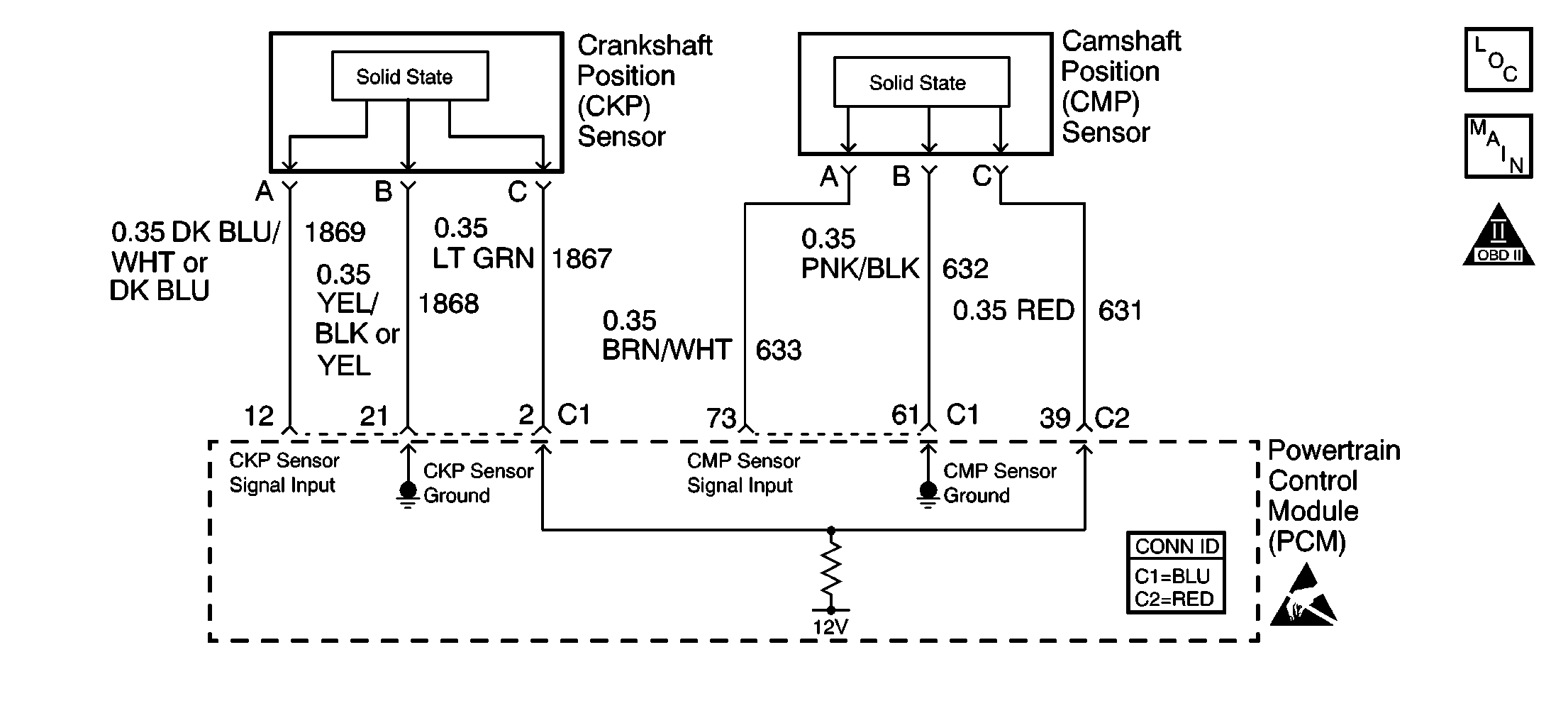
Circuit Description
The camshaft position (CMP) sensor is mounted through the top of the engine block at the rear of the valley cover. The CMP sensor works in conjunction with a 1X reluctor wheel on the camshaft. The reluctor wheel is inside the engine immediately in front of the rear cam bearing. The PCM provides a 12 volt power supply to the CMP sensor as well as a ground and a signal circuit.
The CMP sensor determines whether a cylinder is on a firing stroke or on an exhaust stroke. As the camshaft rotates, the reluctor wheel interrupts a magnetic field produced by a magnet within the sensor. The sensor's internal circuitry detects this and produces a signal which the PCM reads. The PCM uses this 1X signal in combination with the crankshaft position (CKP) sensor 24X signal in order to determine crankshaft position and stroke. The PCM monitors for a loss of the CMP sensor signal.
Observe that as long as the PCM receives the CKP sensor 24X signal, the engine will start. The PCM can determine top dead center for all cylinders by using the CKP sensor 24X signal alone. The CMP sensor 1X signal is used by the PCM to determine if the cylinder at top dead center is on the firing stroke, or the exhaust stroke. The system attempts synchronization and looks for an increase in engine speed indicating the engine started. If the PCM does not detect an increase in engine speed, the PCM assumes it incorrectly synchronized to the exhaust stroke and re-syncs to the opposite cam position. A slightly longer cranking time may be a symptom of this condition.
Conditions for Running the DTC
The engine speed is less than 4000 RPM.
Conditions for Setting the DTC
The PCM detects that a CMP to CKP mis-match has occurred for 10 seconds.
Action Taken When the DTC Sets
| • | The PCM illuminates the malfunction indicator lamp (MIL) on the second consecutive ignition cycle that the diagnostic runs and fails. |
| • | The PCM records the operating conditions at the time the diagnostic fails. The first time the diagnostic fails, the PCM stores this information in the Failure Records. If the diagnostic reports a failure on the second consecutive ignition cycle, the PCM records the operating conditions at the time of the failure. The PCM writes the conditions to the Freeze Frame and updates the Failure Records. |
Conditions for Clearing the MIL/DTC
| • | The PCM turns OFF the malfunction indicator lamp (MIL) after 3 consecutive ignition cycles that the diagnostic runs and does not fail. |
| • | A last test failed, or current DTC, clears when the diagnostic runs and does not fail. |
| • | A history DTC clears after 40 consecutive warm-up cycles, if no failures are reported by this or any other emission related diagnostic. |
| • | Use a scan tool in order to clear the MIL and the DTC. |
Diagnostic Aids
Important:
• Remove any debris from the PCM\TAC module connector surfaces before
servicing the PCM\TAC module. Inspect the PCM\TAC module connector gaskets
when diagnosing/replacing the modules. Ensure that the gaskets are
installed correctly. The gaskets prevent contaminate intrusion
into the PCM\TAC modules. • For any test that requires probing the PCM or a component
harness connector, use the Connector Test Adapter Kit J 35616
. Using this kit prevents damage
to the harness/component terminals. Refer to
Using Connector Test Adapters
in Wiring Systems.
| • | The following conditions may cause this DTC to set: |
| - | Poor connections |
| - | Refer to Testing for Intermittent Conditions and Poor Connections in Wiring Systems. |
| - | Camshaft reluctor wheel damage |
| - | The sensor coming in contact with the reluctor wheel |
| • | For an intermittent, refer to Symptoms . |
Test Description
The numbers below refer to the step numbers on the diagnostic table.
-
This step verifies that the malfunction is present.
-
This step tests for electromagnetic interference (EMI) on the CMP sensor circuits.
-
Damage to the reluctor wheel would affect the CMP sensor output. Vertical lines across the face of the sensor could indicate foreign material passing between the CMP sensor and the reluctor wheel. This condition would cause this DTC to set.
Step | Action | Values | Yes | No | ||||||
|---|---|---|---|---|---|---|---|---|---|---|
1 | Did you perform the Powertrain On-Board Diagnostic (OBD) System Check? | -- | ||||||||
|
Important: If there are any other CMP DTCs set, diagnose those DTCs first.
Does the scan tool indicate that DTC P0341 failed this ignition? | -- | Go to Diagnostic Aids | ||||||||
Did you find and correct the condition? | -- | |||||||||
4 |
Did you find and correct the condition? | -- | ||||||||
5 |
Did you find and correct the condition? | -- | ||||||||
Did you find and correct the condition? | -- | |||||||||
7 | Replace the CMP sensor. Refer to Camshaft Position Sensor Replacement . Is the action complete? | -- | -- | |||||||
8 |
Does the scan tool indicate that this test ran and passed? | -- | ||||||||
9 | Select the Capture Info option and the Review Info option with the scan tool. Does the scan tool display any DTCs that you have not diagnosed? | -- | Go to applicable DTC table | System OK |
